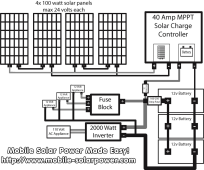chadmichael
New Member
- Joined
- Feb 26, 2022
- Messages
- 52
Assuming the schematic below, the "Classic 400 Watt" system on this web site, and assuming that I udnerstand DC electrical system correctly in that current can only flow in one direction on the circuit, how can the charge controller charge the batteries when anything at all is pulling a load from the batter? It seems to require that current be flowing out the main positive from the battery to, say, the inverter or fuse block, while current is flowing into the batteries from the charge controller at the same time? Isn't this current flowing in two directions on the same positive wire?
How does this work? What am I missing?

How does this work? What am I missing?



